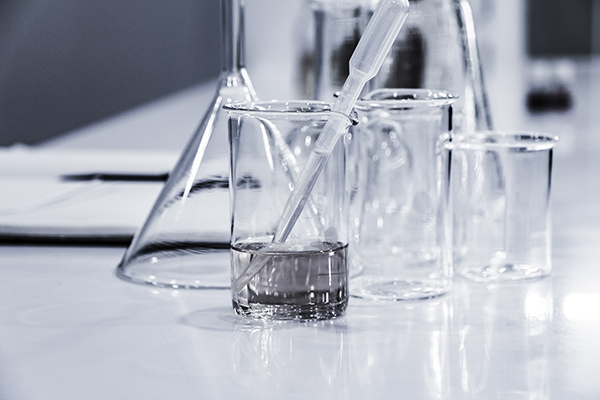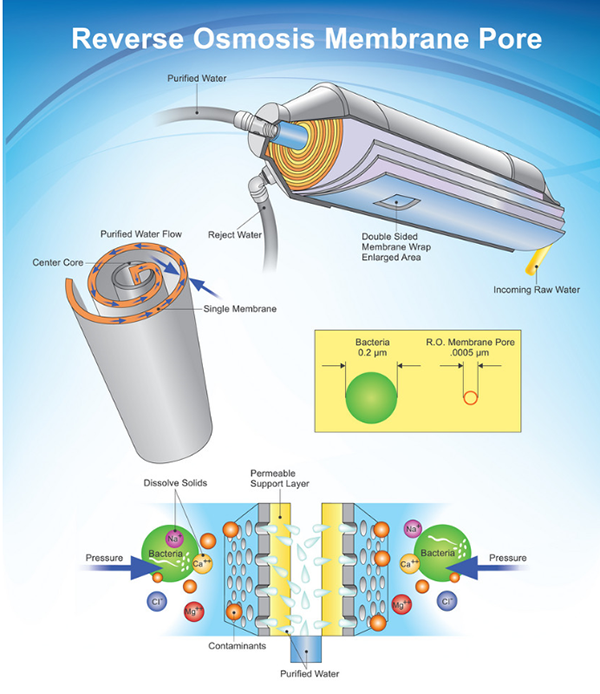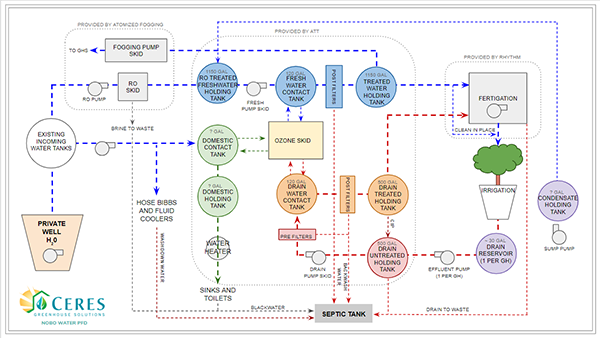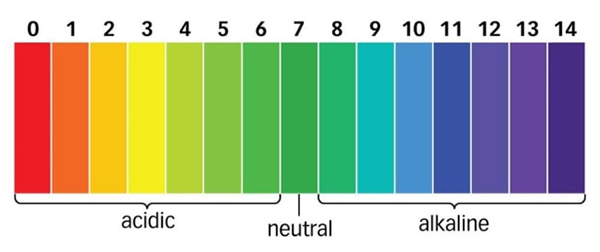Major water quality considerations and ways to treat your water for optimal greenhouse production.
When it comes to irrigation, cannabis cultivators get their water from a variety of sources. Whether it’s well, surface, or municipal water, it’s important to have a water treatment system in place to ensure optimal plant growth. If you’re reading this, you may be wondering if you are taking the right steps to prepare the best water for your cannabis cultivation. We will go over some common misconceptions about water quality and discuss different water treatment strategies so you can decide what setup is right for your cannabis greenhouse operation.
Two major water quality considerations:
1. All water is not the same
Water quality varies tremendously from location to location, and the variations will have different effects on your plants. For instance, municipal water is usually free of sediment, organic load, and microbiologicals because municipalities take great effort to filter and clean the water for customers. On the other hand, municipal water contains chemicals added for disinfection purposes – these chemicals can be detrimental to plant growth. And well water, while it may be free of chemicals, might have pathogens that could negatively affect plant yield, and excess minerals that can damage your infrastructure.
2. Potable water (the water you drink from your faucet) is not always adequate for plants.
Plants and humans have different water quality needs to thrive. Any commercial cannabis cultivation facility, whether it sources from a well or local municipality, should have incoming water tested by a trusted analytical lab.

Assessing your water
Once you have the test results from a lab you can begin to assess how the contaminants in your water might affect your cannabis plants.
Contaminants are commonly measured in ppm (parts per million) which equates to one milligram of contaminant to one liter of liquid (1 mg/L). Contaminants can be grouped into three major types: organic, inorganic, and biological. Organic contaminants are various substances of plant or animal origin, disinfection byproducts, VOCs, herbicides and pesticides. These organic contaminants exist in our waterways and have unknown effects on plant health. Inorganic contaminants found in water include minerals and chemicals like arsenic, lead, chlorine, fluoride and nitrates. And lastly, biological contaminants are organisms living in the water and include bacteria, viruses, protozoa and parasites. These microbiologicals are not only dangerous for human consumption, they can have disastrous effects on plants in the form of disease such as root rot.
Test results will also tell you the pH levels of your water. The pH level will tell you how basic or acidic your water is on a scale of 0(acidic)-14(basic). For cannabis cultivation, the optimum pH range is between 5.5 and 7. Water with pH levels more basic or acidic than this range may affect plant growth.
Your water’s EC (electric conductivity) levels will tell you your water’s ability to conduct an electrical current. Salinity and total dissolved solids (TDS) are used to calculate the EC of water. TDS is also an indicator of a water’s hardness level – which is the measurement of dissolved minerals, such as calcium and magnesium, in the water. The main concern with high levels of hardness is the effect that the minerals may have on your exposed infrastructure – like your pipes and fittings. Also, if your water has higher hardness levels, you will need to take the minerals into effect when creating your plant nutrient recipe.
Water Treatment Options
Once you have a better idea about what unwanted contaminants are in your water, you can start to think about your water treatment options. There are many water treatment options to consider to create an optimal grow system in your cannabis greenhouse. We will go over two of the main ways to purify your water before it goes to cultivation.
The first water treatment option we will discuss is reverse osmosis for growing weed or RO. RO works by pushing water molecules through a semipermeable membrane – filtering out most contaminants.
 Ozone treatment is also popular with cultivators. Ozone is an unstable gas, composed of three oxygen atoms, and is readily used in domestic and industrial water treatment centers. Only recently has it been adopted by growers to benefit their grow operations. Ozone is generated when energy is added to oxygen breaking apart the 02 molecules into unstable oxygen atoms. These oxygen atoms then combine to make 03 molecules, which destroy the unwanted contaminants.
Ozone treatment is also popular with cultivators. Ozone is an unstable gas, composed of three oxygen atoms, and is readily used in domestic and industrial water treatment centers. Only recently has it been adopted by growers to benefit their grow operations. Ozone is generated when energy is added to oxygen breaking apart the 02 molecules into unstable oxygen atoms. These oxygen atoms then combine to make 03 molecules, which destroy the unwanted contaminants.
 Here is a diagram that shows what cannabis water filters you’ll commonly find included with a commercial cannabis water treatment system.
Here is a diagram that shows what cannabis water filters you’ll commonly find included with a commercial cannabis water treatment system.
 The source water (city water) is filtered through some sort of sand or carbon filter before passing through a water softening agent to reduce the hardness. It then goes through reverse osmosis to remove all other contaminants before storage. The purified water in the storage tank is then ready for nutrients to be added to it according to the growers cultivation recipe.
The source water (city water) is filtered through some sort of sand or carbon filter before passing through a water softening agent to reduce the hardness. It then goes through reverse osmosis to remove all other contaminants before storage. The purified water in the storage tank is then ready for nutrients to be added to it according to the growers cultivation recipe.
One thing you will notice about this diagram is the waste stream coming out of the cannabis RO system. This is the RO brine – one of the major drawbacks of using the RO system for your grow room. The brine (also called reject water, waste stream and concentrate) is the byproduct of the reverse osmosis desalination process. This waste product can be up to 50% of the incoming stream, meaning that essentially cannabis RO systems are not water efficient. Not to mention that this waste stream is chalk full of salts, nutrients, metals etc., so it is considered a toxic liquid by many municipalities. Because of this, discharge of this stream can be very difficult. Discharge of cannabis RO brine may require permits, further treatment or additional infrastructure that requires more space – which all come at a high cost. In addition, RO brine can be harmful to the local environment due to its toxicity.
 https://www.saltworkstech.com/articles/how-to-manage-brine-disposal-and-treatment/
https://www.saltworkstech.com/articles/how-to-manage-brine-disposal-and-treatment/
In addition to these burdens, reverse osmosis systems for growing weed have a very high operational energy demand. In comparison, ozone treatment has a much lower operational energy input, does not have brine disposal requirements and has the added benefit of increasing the dissolved oxygen in the fertigation water.
DO (O2) v Ozone (O3)
Higher levels of dissolved oxygen in the root zone of cannabis crops results in larger root mass. Beneficial levels of dissolved oxygen start at about 8ml/l. Water with dissolved oxygen levels below 4ml/l is considered hypoxic. The saturation point of oxygen in water depends on the temperature and salinity but mostly does not exceed 15ml/l. With ozone treatment, we can supersaturate the water with oxygen because O3 is 13 times more soluble in water than O2. Once the ozone is pumped into the water it quickly reverts back to O2 but now there are much greater levels of oxygen in the water. In addition to higher dissolved oxygen levels, ozone treatment can be used to clean the water lines which will reduce maintenance costs and replacement rates of components.
Here at Ceres we believe that your water treatment system should be designed to produce optimal water quality for your plants, while also reducing costs and environmental impacts. Here is a sample flow diagram of one of our innovative solutions. This system not only treats incoming water, but also treats and reuses the nutrient waste and condensate water from the facility in a minimal waste solution.

If you have any questions or would like to know more about a water treatment design for your cannabis operation, contact us. A greenhouse designer is waiting to hear from you!
